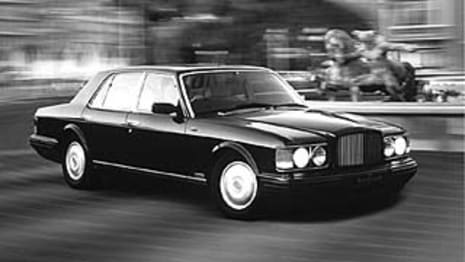
Bentley Brooklands 2008 Review
- Bentley Brooklands
- Bentley Brooklands 1992
- Bentley Brooklands 1993
- Bentley Brooklands 1994
- Bentley Brooklands 1995
- Bentley Brooklands 1996
- Bentley Brooklands 1997
- Bentley Brooklands Reviews
- Bentley Reviews
- Bentley Coupe Range
- Bentley Sedan Range
- Coupe
- Sedan
- Bentley
- Prestige & Luxury Cars
“That is probably the most exciting thing about the Brooklands ... the fact it was almost an accidental program,” Stuart McCullough, board member for sales and marketing, said at the launch of the classic coupe in Tuscany.
“When you finish major model programs, as we had with Continental and Arnage and Azure, sometimes the most difficult thing is keeping your creative designers and stylists occupied."
“The idea of the Brooklands was borne out of a need to keep the designers busy; while it started purely as a styling exercise, it quickly became apparent that it was going somewhere.”
Where the car went, driven by the design pen of Raul Pires and, despite best efforts of Bentley management to kill the project, was to be the latest in a long line of exclusive coupes to wear the flying B emblem.
“This is a true Bentley coupe, influenced by the classic models of the past — the Blue Train from 1930, the Embericos Bentley of '39, the Continental Mulliner of 1959 and Continental T of 1997,” McCullough says. “Yet it is not a sports car; this is a true Grand Tourer.”
In a world where research and development costs for a family car run into hundreds of millions of dollars (GM Holden spent more than a billion on the VE Commodore), the Brooklands program was completed on what the industry would consider pocket change.
“Thirty-five million euro and even at that it was touch and go well into the program,” Peter Guest, head of department for body and trim, said.
Overall, 60 per cent of what is on the Azure is on the Brooklands. The 40 per cent of the Brooklands that is unique to the coupe consists mainly of the roof and rear skin, rear underbody, suspension and damper tunes, a rework of the 6.75-litre V8 to boost power and torque, and extensive reworking of the rear seats to guarantee the most luxurious and spacious rear accommodation of any coupe.
With a production run of only 550 spread over three years — a number predicated by how many cars the company can squeeze down an already full-capacity production line at Crewe — the opportunity to truly hand-build the cars in the traditional sense was too good to pass up.
Each Brooklands is unique. Every one of the 500 orders taken so far — including six from Australia — will include a degree of Mulliner personalisation, whether something as simple as a special colour match or as complex as an interior trimmed in wood from a specific tree.
Even before the bespoke Mulliner division gets involved, the Bentley Coupe is something special.
Each car takes 600 hours to complete — an outrageous figure in a world where cost efficiency has seen other high-end makers popping cars off the line with increasing regularity.
It takes a month for the wood trim for each car to be prepared and cured, with the 10sqm of chosen veneer set on a solid wood substrata. There are 6000 hand-done spot welds on each body. Fifteen metres of copper-braised seams are hand-ground to be invisible under the paint.
Over 125 hours, the 16 hides in each full-leather interior are hand-stitched using 484.5m of thread and 43,507 stitches.
Under the bonnet, the 6.75-litre V8 is Bentley in microcosm. With the core of the thumping great benteight approaching its 50th birthday, there is enormous pride in having a component that has been engineered to last. “We believe it may be the longest-serving engine in the industry,” says Bentley's powertrain main man, Brian Gush.
The original 6.25-litre engine debuted in 1959 and, by 1962, had been bored to its current 6.75 litres. Since the original “sufficient” output (about 230bhp/160kW is as near as anyone will say) the engine has been tweaked, blown and modernised so that the current one claims 395kW (530bhp) and 1050Nm — something the firm is no longer shy about promoting.
Yet, while power has soared, Gush is at pains to point out that NOx emissions are down by 99 per cent and efficiency is up 60 per cent over the original engine.
On the road, the Brooklands delivers most of the things you expect from a Bentley — and more than a couple you don't.
The interior is plush and lush — it could hardly be anything less given the time and materials lavished on it. Craftsmanship and old-world style dominate. Polished pull-knobs and switch gear punctuate the wooden dash treatment, the dials are creamy, rich and prominent, and the knurling on the gear shifter is a work of art.
The first impression of the front of the cabin is that the floor is high — it is because of the straight chassis rails running beneath — and the seating fairly high.
The seats themselves are large and comfortable but not particularly well bolstered — not an issue, you may reasonably think, in a luxury grand tourer. Not so, given the performance capability of this car.
Rear seat space — in any limousine let alone a coupe — is expansive. The two rear seats are electronically adjustable, with leg and headroom difficult to fault. Entry and exit is not simple, even with the large front doors, as the low roofline demands a degree of dexterity.
Punch the starter button and such issues fade into insignificance. The big V8 fires up quietly — unbelievably quietly for an engine of its size — but that can all change in an instant.
Jumping on the accelerator is akin to poking a sleeping bear with a sharp stick. Instantly, there is a fierce rumbling and a sense of life, followed almost instantly by a ferocious release of energy.
With the twin turbos forcing the engine to take deep breaths, the Bentley throws its 2.7 tonnes down the road at an alarming rate.
A 5.3 second 0-100km/h sprint may not make a Porsche driver wince but from inside a behemoth like the Brooklands it is breathtaking.
Yet, the car is far more than a rocket sled. There is an impressive stiffness to the chassis and a comforting degree of feedback from the huge bespoke 255/40 ZR 20-inch rubber developed for the Brooklands by Pirelli.
The big car turns in progressively and tracks truly with a mechanical grip that beggars description. A dynamic stability program is standard on the car but, during the launch drive on winding Italian mountain roads, provoking it into action took more aggression than we were prepared to apply.
The standard brake package is impressive enough — 348mm ventilated discs front and 345mm rear — but for the cost of a mid-sized family car ($25,000 or so) you can upgrade to monstrous 420mm carbon/silicon carbide cross-drilled discs on the front with eight-pot calipers. The rears are a not-inconsiderable 356mm with both front and rear discs guaranteed for the life of the car.
10 things you won't get in a commodore
1 Almost 2.7 tonnes of hand-built bespoke metal
2 A 6.75-litre twin turbo V8 hand-built and signed by the team leader
3 Torque of 1050Nm to go with the 395kW of plush power
4 103.5 billion standard colour and trim combinations
5 A full leather interior hand-sewn using the hides of 16 cows
6 Hand-polished stainless steel exterior brightwork
7 The option to upgrade to 8-pot, 420mm carbon ceramic brakes that will stop an ocean liner for a trifling $25,000.
8 No reach adjustment on the steering wheel
9 Combined cycle fuel consumption of 19.5L/100km or an urban average of 28.8L/100km
10 A sticker price of $693,000 plus on-road costs
Pricing guides
Range and Specs
| Vehicle | Specs | Price* | |
|---|---|---|---|
| (base) | 6.8L, PULP, 4 SP AUTO | $69,850 – 80,300 | 1994 Bentley Brooklands 1994 (base) Pricing and Specs |
$69,850
Lowest price, based on third party pricing data











